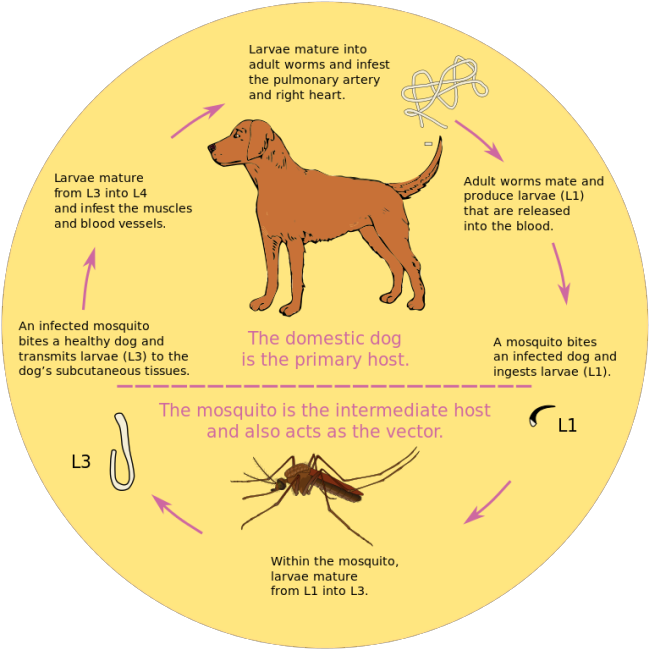
Heartworms are one of the most serious parasites an animal can contract. Beginning as microfilaria in the bloodstream mosquitos, the insects store the bacteria in their salivary glands, which then develop into infected larvae which the mosquito deposits into the animal it stings. The larvae then begins to develop inside the host animal for the next 6 months. The worms then grow in the heart and arteries for as long as 5-7 years before the host is eventually killed. This parasite is one of the deadliest. Both cats and dogs can contract these vile worms, but the de-worming medication only proves effective on canines. Though felines are less likely to get heartworms, those who contract the worms have no hope for survival. Without treatments, dogs survive for 5-7 years before passing, while cats hardly make it past 2-3 years.
Causes: When mosquitos bite a cat or dog, the microfilaria pass through the blood stream, developing into larvae. These migrate to the heart and arteries and then not only begin to grow and expand (some female heartworms can grow into 13-14 inch long worms), but they also reproduce by emitting more microfilaria into the bloodstream. This increases the presence of the heartworms, which is why some animals are discovered to house a tangle of web-like worms living inside the life-giving organ. Since cats’ bodies are described as atypical hosts for the heartworms, the parasites rarely grow to a reproductive adult stage, and cats generally only ever have 2-3 worms. The presence of these worms still poses a serious threat to feline health, and ought to be protected through preventive medication. Since heartworms are contracted through mosquito bites, cats and dogs that live in humid or tropical areas are highly at risk.
Symptoms: Heartworms can cause symptoms like blood clots or aneurysms, as well as dilated vessels. This strain will cause the animal to cough, struggle with shortness of breath, or even get occasional nosebleeds. Animals with heartworms may show signs of rapid weight loss, decreased appetite, fatigue, lack of stamina in exercise, and vomiting, etc. Cats can also have seizures, sudden collapse, swelling of the abdomen and sudden death.
Treatments: During the month of April, most veterinarians begin screening dogs and cats for signs of heartworms, as they only begin showing signs after the mosquito-heavy humid seasons. Oral medications/de-worming pills can be administered monthly to dogs and cats during the months of mosquito season (generally Spring-Fall). Some pet owners also apply bug spray to their pets’ coat to ward off any pesky mosquitos. However, if the de-worming pills fails to work, dogs can undergo injections of adulticides which kill the worms inside the organs. This treatment can be very taxing, so exercise must be strictly limited while the canine recovers. In extreme cases, the heartworms can also be surgically removed, yet all anti-worming procedures must be followed by preventative medication to help guard against future infestations. Since feline heartworms are more difficult to detect and are not possible to fully cure, the best method of protection is to regularly administer preventative medicine.

